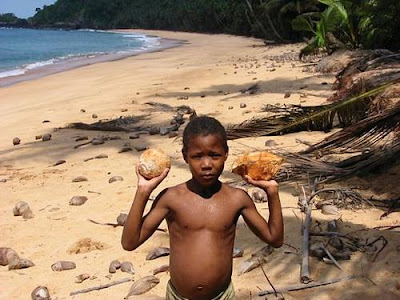 São Tomé , also known as "the Chocolate Island," has always been renowned for it's cocoa's high quality.
São Tomé , also known as "the Chocolate Island," has always been renowned for it's cocoa's high quality.São Tomé is one of the few remaining spots in the world not compromised by mass tourism. It is a tropical paradise, with white palm fringed beaches, crystal clear water, unexplored jungle with endemic species, and a friendly people who rarely see any visitors.
From the late 1400s, Portuguese navigators explored the islands, and decided that it would be a good location for bases to trade with the mainland. The Portuguese began settling convicts on
In the sixteenth century, the islands’ sugar cane trade was economically dominant and led the world. Later on, the plantation cultivation of coffee and cocoa was developed; by the start of the 20th century, the islands, and their impressive large-scale plantations, became the largest cocoa producers in the world. This unique position was based, on the one hand, on the unusual organizational talent of the Portuguese colonialists and traders, and on the other, on the slave-owning economy, which had been standard across the world for centuries.

São Tomé
Promoters of tourism say the islands have plenty for visitors to see, but hurdles include ignorance about the country, the difficulties of getting there, and what some say is an exaggerated fear of malaria.


The scenic islands have potential for tourism, and the government is attempting to improve its rudimentary tourist industry infrastructure.

Since the 1800s, the economy of São Tomé and Príncipe has been based on plantation agriculture. At the time of independence in 1975, Portuguese-owned plantations occupied 90% of the cultivated area. After independence, control of these plantations passed to various state-owned agricultural enterprises, which have since been privatized. The dominant crop on São Tomé is still cocoa, representing about 95% of exports. Other export crops include copra, palm kernels, and coffee.

Domestic food-crop production is insufficient to meet local consumption, so the country imports some of its food. In recent years, efforts have been made by the government to expand food production, and several projects have been undertaken, largely financed by foreign donors.
São Tomé
FUN FACTS ON SÃO TOMÉ AND PRÍNCIPE
- São Tomé and Príncipe is the second smallest (in terms of population) African country (larger only than Seychelles).
- Of São Tomé and Príncipe's total population, about 137,500 live on São Tomé and 6,000 on Príncipe. All are descended from various ethnic groups that have migrated to the islands since 1485.
- The majority of the population lives on São Tomé.
- 46 % of the entire population are less than 16 years old.
- The official language is Portuguese.
- Life expectancy Male/66 years, Females/68 years
- Annual average temperature 25 C
- The country has no international disputes whatsoever.

Source and More Information
Official Website São Tomé and Principe

















2 comments:
good posting.i like it. thank u. :)-
www.bathmateus.com
In Australia along with Nz, ugg shoes or boots have got always been liked by individuals countryside vocations, including sheepcheap ugg boots, who've all set accessibility to garbage necessary to produce a shoe honestly. Their particular reputation elevated as a result of The first world war along with World War II, after they were well-liked by aviators, for their must preserve hot in [url=http://www.bootsalso.com/]uggs boots on sale[/url]aircraft from substantial http://www.bootsos.com/.
Post a Comment